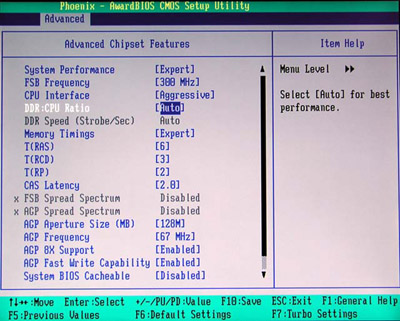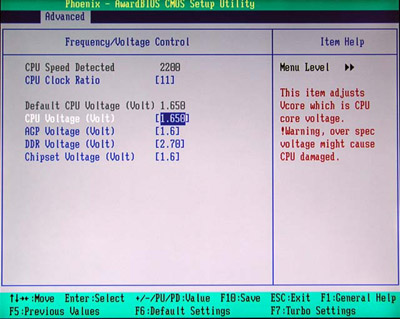Albatron KX18D PROII: nForce2 Ultra with Memory Ratios
by Wesley Fink on September 16, 2003 10:59 PM EST- Posted in
- Motherboards
Albatron KX18D PROII: BIOS and Overclocking
Albatron uses the familiar Phoenix Award BIOS on the KX18D PROII. Our board was tested with the release v1.0 BIOS. In the short time Albatron has been making motherboards, they have developed quite a reputation for catering to the “wish-list” of computer enthusiasts. The tweaking options available on the KX18D PROII will only enhance that reputation.
Most of the tweaking options are in the Advanced Menu, which has submenus for Advanced BIOS Features, Advanced Chipset Features, PnP/PCI Configurations, and Frequency/Voltage controls.

System and Memory Timings are adjusted in the Advanced Chipset Features menu. CPU FSB is set here with a range of 100-300. The overclocking and tweaking options available are the best we have seen on any nForce2 Ultra 400 board — including the excellent options on the Epox board.


The Albatron options for memory ratio selection are unique on an nForce2 Ultra 400 board. With the available options, you can set DDR400 memory, for example, to any speed from DDR200 (1.0) to DDR800 (4.0), while the CPU remains at stock speed.

The Frequency/Voltage Control section is where CPU multipliers and voltages are set. Again, the available ranges are impressive.

vCore or CPU voltage can be set to an incredible 2.65V, which would surely destroy a CPU cooled with conventional air. However, water-cooling and phase-change advocates will welcome this range. This incredible range makes it even more disappointing that Albatron left out the 4 mounting holes around the CPU.
You will also find a vDimm range here of 2.5V to 3.0V, which is a wider range than we see on most boards. It is also a useful range since several recent dimms can be used at 3.0V without violating their warranty.

PC Health functions are included in the HW Monitor section. Monitoring functions include System, CPU, fan speed monitoring for 2 on-board fan connections, Vcore, and Power Supply readings for all rails. Albatron also provides a simple over-temperature CPU Protection feature that can be enabled/disabled with onboard jumper J4.
BIOS options for the KX18D PROII overall provide the end-user with the widest range of tweaking options that we have seen on an nForce2 Ultra 400 board. We can only suggest that some of the options provide settings that can destroy your CPU if misused, so be cautious. Overclockers will be in rapture. While Albatron has distinguished the KX18D with tweaking options, we really need to see the 4 mounting holes and an even more robust power regulation system to proclaim this as the Overclocker’s dream board. It’s close.










8 Comments
View All Comments
EricTheHarwareHacker - Sunday, March 14, 2004 - link
I wonder which boards use cheap capacitors and whatnot. I don't want my machine to crash and burn 1-2 years down the road! Anand should cover such things that are hard for a buyer to know.Anonymous User - Wednesday, October 8, 2003 - link
#6, you're an idiot, EVERYONE uses flash and its usage is only going to go up. Get a clue.sean8102 - Thursday, August 30, 2018 - link
I know this ANCIENT, but this comment made me laugh out loud. Thankfully I can confirm flash is dead, just took a few more years.Anonymous User - Sunday, October 5, 2003 - link
Please stop using FLASH in the review. It is NOT "here to stay", on the contrary, it's on the way out, people are tired of it and often disable it... I for one won't disable flash, I'll just go elsewhere. I know, no tears for my leaving, but it IS a trend, alienating frequent visitors/participants at AT CAN'T be a good thing.Anonymous User - Saturday, September 20, 2003 - link
Yeh, ever heard of abit nf7-s? Try it.Anonymous User - Wednesday, September 17, 2003 - link
The Abit NF7-S ver2.0 has memory to CPU ratio adjustments also.Wesley Fink - Wednesday, September 17, 2003 - link
Corrected. There are 3 slots as seen on other nForce2 Ultra 400 boards.Anonymous User - Wednesday, September 17, 2003 - link
On page 2 you mention "Four 184-pin DDR DIMM Slotsin Dual-Channel Configuration" but on page 3, the picture only shows three.